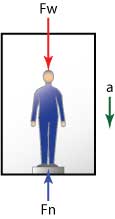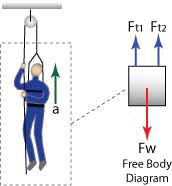| Practice Test | Study Guide |
|
Objectives |
||
| Essential Question: Is mass in physics the same thing as the amount of matter present? | ||
Homefun (formative/summative assessment): Read 5.1 to 5.5
Relevance: Newton's laws revolutionized science and ushered in a new era of technological development. Even today over 300 years later they are the foundation of modern engineering.
|
|
Activities |
|
Lesson 1 Pre-assessment: Use the internet to answer questions 21 - 26 on the Basic Physics Savvy Quiz Key Concept: Newton's laws, free body diagrams. Purpose: Solving acceleration problems using free body diagrams. Interactive Discussion: Objectives. What would the world be like if Newton's first law were turned off. In other words, what if motion required a net force to keep it going. A bus hits a bug. Which has the higher force a bug or a bus? Draw free body diagrams. In Class Problem Solving:
|
| Essential Question: If forces always come in pairs, how can anything move? |
FBDs, g, and Acceleration
-
Identify action/reaction pairs of forces.
-
Draw free body diagrams.
- Generally shows the object as a square or a dot.
- Shows only forces from the outside acting on the object. The forces are shown touching the object.
- Never shows forces the object creates on the outside world.
-
State 3 ways "g" can be defined.
- Acceleration of a free falling body with no air resistance on planet Earth = 9.80665 m/s2
- Unit of acceleration. 1.0 g = 9.80665 m/s2
- Gravity-field strength typically used for calculating weight force. On planet Earth g = 9.81 m/s2
-
Calculate the weight force acting on an object: Fw = mg Note that the g in this case is the strength of the gravity field.
-
Correctly identify normal forces. Normal forces are forces generated when one surface presses against an object. Normal forces are always perpendicular to the surface causing them.
formative/summative assessment: vocaulary quiz
| Essential Question: When you step on a bathroom scale, which force is the scale actually measuring? |
Elevator Problems
-
Explain which external force acting on a person causes the sensation of weight. The normal force
-
 Solve elevator problems.
Solve elevator problems.
- "g" is a gravity-field strength vector not an acceleration.
- "g" is negative because it points downward.
- Fw = mg
- The scale the person stands on indicates the normal forc not the weight or gravity force
- Solve elevator type problems in a horizontal dimension. These have 2 opposing forces in the horizontal dimension. The equation ends up being identical to the elevator problems.
-
 Solve 2 cable elevator problems.
Solve 2 cable elevator problems.
Here the person can be visualized as pulling himself up using a rope and pulley.
As is often true, the trick for solving the problem is drawing a correct FBD.
Homefun (formative/summative assessment): Read 5.6, prob. 1, 3, 33, 51 pp. 128-131
-
 Read:
Insultingly Stupid Movie Physics
Read:
Insultingly Stupid Movie Physics - Chapter 10, Acceleration and Newton's Second Law: How to get started, Use the Breaks, or Change Direction Hollywood Style, pp 147 - 163
Relevance: Most engineering majors will be required to take a dynamics course based primarily on Newton's Second Law. Dynamics analysis is critical to machine design, an important issue for mechanical engineers .
Lesson 2 Key Concept: Free body diagrams (FBD) Purpose: Enable one to identify the forces that belong in a Newton's second law equation Interactive Discussion: What causes the sensation of weight? Video Clip: Show a video clip of the rocket sled ride in Indiana Jones. Assume Jones weighs 180 lb and is subjected to 10 g of acceleration as the sled speeds up and 40 g acceleration while stopping. What would be the size of the force between Jones and his seat while speeding up? What size force would be required to hold Jones on the sled while slowing down? In Class Problem Solving: elevator problems
|
Pushing, Pulling, and Cliff Hangers
Metacognition Problem Solving Principle: A teacher can guide a student to the solution of a complex problem merely by asking questions, but first the student must first learn to answer rather than simply follow the teacher's instruction. Ultimately, the student can solve problems without the teacher by learning to ask himself or herself the questions. Problem solving is about asking questions. Homefun (formative/summative assessment): Read 5.6, prob. 31 pp. 128-131
|
Lesson 3 Key Concept: Free body diagrams (FBD) Purpose: Enable one to identify the forces that belong in a Newton's second law equation Interactive Discussion: Objectives. Video Clip: Show a video clip of the bus hanging scene in Jurassic Park In Class Problem Solving:
|
|
|
| Title | Analysis of an Air Track Slider Accelerated by a hanging weight |
| Purpose | Determine if simple mathematical models can predict the behavior of an air track slider accelerated by a hanging weight. |
| Overview |
By knowing the final velocity and distance the slider's acceleration can be calculated. Compare this acceleration to one calculated from theory. Assume the pulley at the end of the track along with the string pulling the cart are frictionless and massless. |
| Data, Calculations | Calculate a % difference between the measured and theoretical acceleration |
| Questions, Conclusions |
|
| Resources/Materials: | Air track and slider. Photogates computer system set up with Vernier LabPro software and Lab Pro units |
Objects on Slopes
Homefun (formative/summative assessment): 22, 24 pp.128-131 Relevance: Components on a slope is the first step in analyzing numerous real world problems from ramps for unloading cargo to 4WD vehicle climbing performance . |
Lesson 4 Key Concept: Normal and parallel components on a slope Purpose: Enable one to solve slope problems Derivation: weight components on a slope. In Class Problem Solving:
Group problem solving: Plot the acceleration, normal, and parallel forces vs angle. Draw conclusions from the plots.
Resources/Materials: |
|
Formal Physics Investigation |
|
| Title | Measurement of g Using an Air Track |
| Category | Newton's Laws |
| Purpose | Measure g using an air track |
| Models | kinematic equations, F = ma (Note: if kinematic equations can be used, then what do you know about the slider's acceleration?) |
| Overview | A slider can "fall" down the slope of an air track set at an angle with respect to the horizontal. You are to devise an experiment for determining the value of g by using the air track and other equipment provided. |
| Safety Issues | Air track motors can overheat if the air inlet is blocked. |
| Equipment Limitations | Air tracks an their sliders are much more delicate than they look. Do NOT drop or strike them |
| Resources/Materials: | Air track and slider. Photogates computer system set up with Vernier LabPro software and Lab Pro units |
Statics (the first half of the story)
Homefun (formative/summative assessment): prob. 21, 23, 27, 35 pp. 128-131 Relevance: Statics calculations are the first step in designing structures, an importance issue for both civil and mechanical engineers. |
Lesson 5 Key Concept: Static equilibrium Purpose: Solve static cable problems. Interactive Discussion: Can the tension in a rope be greater than a perpendicular force exerted in its center it? In Class Problem Solving:
|
